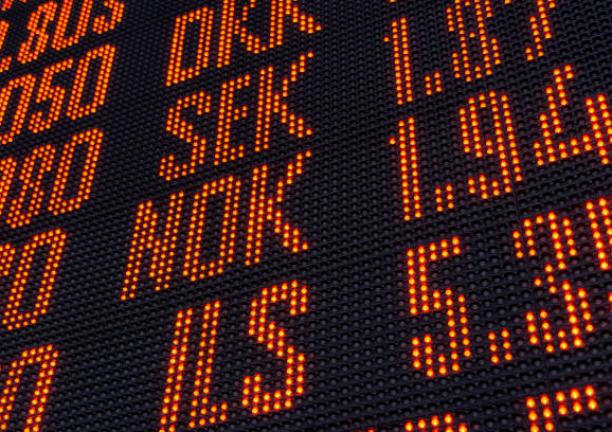
Sustainable Bottom Line: A common thread across the ten worst performing funds is exposure to small-cap and mid-cap stocks, segments that were challenged in 2025.

CONTACT US
Directly for advertising opportunities.
Welcome to sustainableinvest.com, maintained by Sustainable Research and Analysis. We provide insightful research and analysis for investors and other stakeholders interested in and committed to sustainable investing.
GET STARTED

Green preferred shares: A niche tool for sustainable income investors
Sustainable Bottom Line: Occupying a niche corner of the capital markets, a small number of green preferred stocks offer potential attractions but also pose risks.

|
Current Sustainable Investing Research |
Sign up to free newsletters.
By submitting this form, you are consenting to receive marketing emails from: . You can revoke your consent to receive emails at any time by using the SafeUnsubscribe® link, found at the bottom of every email. Emails are serviced by Constant Contact
| Top 10 Performing Funds November 2025 | ||
|---|---|---|
| Fund Name (MF/ETF) | 1-M (%) |
12-M (%) |
| Eventide Healthcare & Life Sciences I | 13.31 | 59.71 |
| Victory Global Energy Transition Y | 8.33 | 62.06 |
| KraneShares European Carbon Allowance Strategy ETF | 6.73 | 29.35 |
| iPath® Series B Carbon ETN | 6.29 | 17.49 |
| Neuberger Berman Engy Trnstn & InfrasETF | 5.29 | 7.79 |
| Quantified Common Ground Investor | 5.24 | 1.94 |
| iShares Transition-Enabling Metals ETF | 5.04 | 37.21 |
| Boston Trust Walden Small Cap | 4.58 | -2.33 |
| USCF Dividend Income ETF | 4.34 | 12.4 |
| VanEck Environmental Svcs ETF | 3.96 | 12.44 |
| Average | 6.31 | 23.81 |
| Best performing share classes only. Source: Morningstar Direct. |
||

Chart of the Week – January 5, 2026: 10 worst performing funds YTD
Sustainable Bottom Line: A common thread across the ten worst performing funds is exposure to small-cap and mid-cap stocks, segments that were challenged in 2025.

Chart of the Week – December 29, 2025: Strong sustainable funds performance in 2025
Sustainable Bottom Line: Based on their absolute performance results, focused sustainable long-term funds are expected to end 2025 on a strong to very strong note.

Chart of the Week – December 22, 2025: Sustainable money market funds
Sustainable Bottom Line: Sustainable money market funds, or funds that employ portfolio-based sustainability and ldquo;structural sustainability,rdquo; settled at $127.6 billion in assets in November 2025.

Chart of the Week – December 15, 2025: Top group annuity providers
Sustainable Bottom Line: Six-group annuity providers lead across broad factors likely evaluated by fiduciaries and sustainable investors considering guaranteed lifetime income inside defined contribution plans.
Published monthly, the Sustainable Funds Monitor provides a timely, monthly snapshot of trends and developments within the sustainable investing market segment, viewed through the lens of mutual funds and ETFs.
Useful for screening funds and constructing sustainable portfolios, SRA Fund Quality Ratings combine qualitative and quantitative evaluations expressed along a five-point scale that runs from A (highest quality) to E (lowest quality). Once assigned, ratings are updated on a periodic basis.
Investors and financial intermediaries can access and review various resources and tools that will be updated, as required, and expanded to include additional related resources and tools over time. Currently available is a Risk Tolerance Investor Questionnaire for assessing an investor's financial profile, including their goals and objectives, risk tolerance and investment time horizon, and a Sustainable Investor Preferences Questionnaire designed to assess an investor’s interest in and preferences for sustainable investing.
Green preferred shares: A niche tool for sustainable income investors
Sustainable Bottom Line: Occupying a niche corner of the capital markets, a small number of green preferred stocks offer potential attractions but also pose risks.
December 31, 2025 Read More »
How family offices approach sustainable and impact investing
Sustainable Bottom Line: Family offices represent an important slice of the estimated $3.7 to $30 trillion in AUM linked to the sustainable investing market segment.
December 30, 2025 Read More »
Sustainable Investing Monitor-December 1, 2025
Sustainable Bottom Line: Sustainable funds dip slightly lower in November, at $377.7 billion; no new funds were launched; three of six selected sustainable indices outperformed.
December 26, 2025 Read More »
Focused sustainable funds: Visible but still a niche
Sustainable Bottom Line: Focused sustainable mutual funds and ETFs remain a niche segment, constrained by limited scale, the lack of standardization and uneven investor adoption.
SUSTAINABLE INVESTING SOLUTIONS THROUGH MUTUAL FUNDS AND ETFs

Actionable Sustainable Investing Ideas
Discover our thoughts and ideas targeting sustainable investing strategies executed through various registered and non-registered sustainable investment funds and products. Our coverage extends to a wide array of investment vehicles, including mutual funds, Exchange Traded Funds (ETFs), Exchange Traded Notes (ETNs), closed-end funds, Real Estate Investment Trusts (REITs), Unit Investment Trusts (UITs), private/direct/local small business loans and investments via digital platforms, stocks as well as bonds. We also cover leading investment management firms as well as specific fund groups, providing a broad perspective on opportunities in the sustainable investing market segment.
Getting Started with Sustainable Investing
Many questions have surfaced in recent years regarding sustainable and ESG investing. Here, investors and financial intermediaries will find essential materials that describe the various approaches to sustainable investing and their practical implementation.
Sustainable investing is an approach that incorporates ESG considerations, i.e. environmental, social and governance factors, into investment decision making with the dual aim of achieving financial returns and positive social and environmental outcomes over time. While sustainable investment strategies vary and have thus far defied universally accepted definitions, most practitioners agree that sustainable investing refers to a range of strategies that combine traditional investment approaches with environmental, social, and governance (ESG) insights. This contributes to a more comprehensive analysis, better investment decisions in terms of risks and opportunities and an alignment of values based on the preferences expressed by investors.
The range of sustainable investing strategies fall into the following broad categories: Values-based investing, screening and exclusions, impact investing, thematic investing, and ESG integration. These approaches are not mutually exclusive and, in conjunction with each of these approaches, investors may also adopt various issuer engagement procedures covering stock holdings as well as bonds, and proxy voting practices. It’s important to remember that sustainable investing approaches and practices will continue to evolve.
In addition to periodic updates regarding sustainable investing and how this form of investing is evolving, investors and financial intermediaries interested in implementing a sustainable investing approach will also find source materials that cover basic investing themes as well as asset allocation strategies, providing a holistic view for portfolio construction.
In-Depth Sustainable Investment Research
Our platform offers extensive research and analysis focused on sustainable investing to keep sustainable investors up to date on a broad range of topics. This includes but is not limited to the following:
- Trends and developments in sustainable investing and sustainable finance.
- Regulatory updates relevant to the sustainable finance landscape.
- Performance results and key considerations for sustainable investments.
- Insights into investing through index funds versus actively managed portfolios.
- Asset allocation updates tailored for sustainable portfolios.
- Analysis of expenses, ESG ratings, and critical data sources.
- Company and product news within the sustainable investing sector.
- Information on green, social, and sustainable bonds, as well as green bond funds.
- Best practices for reporting and disclosure in sustainable finance.
TOPICAL SUSTAINABLE RESEARCH ARTICLES OF INTEREST
COP 28 could stimulate performance of clean energy funds
The Bottom Line: Fast tracking the energy transition at COP 28 could stimulate the performance of clean and renewable energy funds, overcoming recent poor performance.
Read More »
Interest in sustainable investing not diminishing
The Bottom Line: The campaign against ESG considerations by investment managers and investors shows no evidence so far that interest in sustainable investing is diminishing.
Read More »
SUSTAINABLEINVEST.COM
SustainableInvest.com serves as a destination source for sustainable investment management information, in-depth sustainable research and analysis, expert opinions, and actionable sustainable fund quality ratings.
✔ Registration is free
✔ Get Updates
✔ Support Sustainability
✔ Original, Independent,
Thought Leadership
A Decade of Sustainable Funds Investing: 10 Years/10 Charts
Assets of sustainable mutual funds and ETFs close 2019 at $1.6 trillion, up from $113.5 billion ten years ago The total net assets of mutual funds and exchange traded funds (ETF)(1) sourced to sustainable investing approaches expanded dramatically in the last decade, adding almost $1.5 trillion in the last ten years.
Read More »
Are Tesla’s Senior Notes Green? Analysis of Tesla’s Sustainable Bonds
Since the announcement on August 11 and successful placement of Tesla’s $1.80 billion Senior Notes, some disappointment has been expressed by the fact that Tesla didn’t formally qualify as green the company’s newly issued notes.
Read More »

NEW RELEASE
 |
NEW RELEASE |

CONTACT US
Directly for advertising opportunities.
 |
CONTACT US Directly for advertising opportunities. |
Introducing our new release of sustainableinvest.com. We publish investment research and analysis for the benefit of sustainable investors and other stakeholders.
Original, independent, thought leadership
Our core mission is to publish original, independent, and thought-leadership investment research and analysis. This informs decision-making in the sphere of sustainable investing and helps track critical trends and developments in the sector. Anchored in a defined classification framework for sustainable funds, our research activities extend comprehensively to investment strategies, portfolio construction, and the various investment alternatives encompassing sustainable investing across a diverse range of investment products. These include, for example, mutual funds, exchange-traded funds (ETFs), exchange-traded notes (ETNs), closed-end funds, REITs, MLPs, private/direct/local small business loans and investments via digital platforms as well as individual securities such as stocks, long and short-term bonds, including green bonds, social bonds, and sustainable bonds.
We methodically cover the broad arc of sustainable investing approaches. This ranges from
values-based investing, screening and exclusions, impact investing, thematic investing, ESG integration, shareholder/bondholder engagement, and proxy voting practices.
Our content is primarily intended to educate, inform, and guide a broad audience of investors and financial intermediaries. This includes asset owners, such as endowments, foundations, and pension funds, as well as distributors, wealth management platforms, robo-advisors, family offices, and other crucial sustainable investing stakeholders.
Why focus exclusively on sustainable investing?
The landscape of sustainable investing has seen rapid growth in recent years, marked by an increasing number of investors, expansion in the number of investment managers operating in this market segment, expansion in the number and type of investment product offerings, and a significant accumulation of assets under management. This growth has occurred during a time when sustainable investing has continued to evolve but without the benefit of widely accepted sustainable investing frameworks, definitions, and rules. In turn, this has contributed to confusion and misunderstanding regarding the true meaning of sustainable investing, and related to this, the financial and non-financial expectations or outcomes associated with sustainable investment product offerings.
A particular area of misunderstanding has been the fact that in the process of pursuing financial goals and objectives as well as sustainability preferences, certain sustainability goals, or non-financial-oriented goals, may require investors to accept some trade-offs between the achievement of their sustainability preferences and their financial outcomes. These trade-offs will vary in line with the sustainable strategy that investors may wish to implement. Fortunately, these trade-offs can be measured, and investors can decide on the risk-return trade-offs they are willing to accept to achieve their financial and sustainability preferences.
Affecting a broad range of participants, including investors, regulators, managers, politicians, and other stakeholders, it has become increasingly difficult to differentiate between various funds and their stated sustainable strategies and intended outcomes, if any. This makes it more challenging for investors and financial intermediaries to align investment products with the sustainable goals, objectives, and values expressed by investors. As sustainable products continue to evolve and expand in number, there is a growing risk that fund strategies might diverge from investor expectations, a phenomenon commonly known as “greenwashing,” or may not align with investor beliefs or values, potentially leading to disappointments or, in severe cases, redemptions and even litigation. The recent politicization of ESG is, in part, yet another manifestation of this complex issue.
By closely monitoring, scrutinizing, and reporting on these trends and developments, an independent, original, and research-driven information source, such as sustainableInvest.com, can provide invaluable support to investors, financial intermediaries, and other stakeholders. Our analysis aids them in effectively navigating the current state of confusion and misunderstanding prevalent in this dynamic sector of investing.
What is sustainable investing? Core Approaches Explained

Sustainable investing is an approach that incorporates ESG considerations, i.e. environmental, social and governance factors, into investment decision making with the dual aim of achieving financial returns and positive social and environmental outcomes over time. While sustainable investment strategies vary and have thus far defied universally accepted definitions, most practitioners agree that sustainable investing refers to a range of strategies that combine traditional investment approaches with environmental, social, and governance (ESG) insights. This contributes to a more comprehensive analysis, better investment decisions in terms of risks and opportunities and an alignment of values based on the preferences expressed by investors.
The range of sustainable investing strategies falls into the following broad categories:
Values-based Investing: A strategy based on the guiding principle of investments that align with a set of faith-based or religious beliefs, ethical, moral, environmental or social mandates, aimed at achieving a positive societal outcome. Typically, this approach is executed via negative screening, divestiture, or divestment from companies or sectors misaligned with specific values.
Screening and Exclusionary Investing: This involves the overweighting or underweighting of stocks, bonds and other instruments in portfolios based on their ESG scores or categorically excluding securities, companies or certain sectors or industries as eligible securities based on specific ethical, religious, social or environmental guidelines or preferences. Traditional examples of exclusionary strategies cover the avoidance of any investments in companies fully or partially engaged in activities like gambling, sex-related industries, the production of alcohol, tobacco, firearms, fossil fuels, or even nuclear energy. These exclusionary categories have been extended in recent years to incorporate serious labor-related actions or penalties, compulsory or child labor, human rights violations, and genocide. Screening can also extend to positive/best in class screening or norms-based screening in which issuers may be selected on the basis that they would outperform peers on specified ESG metrics or exceed a minimum ESG-rating threshold or excluded when issuers violate international standards such as the UN Global Compact, OECD Guidelines or ILO conventions.
Impact Investing: A relatively small but growing segment of sustainable investing, impact investments are directed to companies, organizations, and funds with the explicit intention to achieve measurable social and environmental impacts alongside a financial return. The direct capital in this strategy addresses challenges in sectors such as sustainable agriculture, renewable energy, conservation, microfinance, and affordable and accessible basic services, including housing, healthcare, and education.
Thematic Investing: An investment approach with a focus on a particular idea or unifying concept. Clean energy, clean technology, and gender diversity are a few of the leading sustainable investing fund themes. Investing in green, social, and sustainability bonds or low-carbon-emitting stocks, bonds, and funds also falls into the thematic investing category.
ESG Integration: This investment strategy involves the systematic, ongoing analysis of financially material environmental, social, and governance factors and risks. When deemed relevant and material to an entity’s long-term financial performance, these factors directly influence the buy, hold, and sell decisions of a security. Within this category of sustainable investing, significant variations exist regarding how ESG integration is deployed in investment portfolios. That said, no automatic restrictions on the investable universe are implied.
Engagement/Proxy Voting: Employed either in conjunction with one of the above-mentioned categories or on a stand-alone basis, this approach leverages the power of stock ownership in publicly listed companies and, on a more limited basis, bond investments. At one of the range, investors may seek information regarding a company’s strategies through direct corporate engagement and exercising proxy voting responsibilities. But investors can exercise their ownership rights through action-oriented methods to influence corporate behavior, file shareholder proposals, and approach proxy voting in a more strategic manner. While not owners, bond investors can also leverage their power of scale as investors, but their scope and leverage are more limited.
It should be noted that these approaches are not mutually exclusive. In practice, investors often blend several techniques. e.g., ESG integration plus thematic tilts plus active stewardship—to balance risk, return and real-world impact.
Navigating the Sustainable Investment Landscape: Key Insights for Informed Decisions
Sustainable investing may seem complex, but understanding its core drivers and benefits is straightforward. Firstly, it’s about aligning your investments with your values, moving beyond pure financial returns to consider broader societal and environmental impacts while also understanding and proactively accepting any trade-offs that may be involved. This values-driven approach fosters a more meaningful connection to your portfolio. Secondly, the increasing demand for sustainable products is driving significant innovation and growth in this sector, creating new opportunities for long-term investors. Finally, robust, sustainable research and analysis are crucial. It helps investors cut through the noise, identify investment opportunities, and avoid potential “greenwashing,” ensuring their investments genuinely align with their sustainability preferences and deliver on their expectations. Our independent analysis empowers you to make smarter, more sustainable choices.
SUSTAINABLE RESEARCH AND ANALYSIS

Why offer research dedicated exclusively to sustainable investing?
The rapid expansion in the number of investors, investment managers, product offerings and assets under management and the continuing evolution of sustainable investing without the benefit of widely accepted sustainable investing frameworks, definitions, and rules, have contributed to confusion and misunderstanding regarding this sector of investing, the meaning of sustainable investing, and related to this, the financial and non-financial expectations or outcomes associated with sustainable investment product offerings. Affecting investors, regulators, managers, politicians, and other stakeholders, it has become increasingly difficult to differentiate between various funds and their sustainable strategies and outcomes. This makes it more challenging for investors and financial intermediaries to align investment products with sustainable goals, objectives, and values expressed by investors. As sustainable products continue to expand in number and investors, there is a growing risk that fund strategies might diverge from expectations (“greenwashing”) or may not align with investor beliefs or values and lead to disappointments or worse, in the form of redemptions and possibly litigation. The recent politicization of ESG is another manifestation of this issue.
By monitoring, scrutinizing, and reporting on trends and developments, an independent, original, research-driven information source dedicated to sustainable investing can support investors, financial intermediaries, and other stakeholders in their efforts to negotiate their way through the confusion and misunderstanding evident today in this sector of investing.
Sustainable Bottom Line: The top 10 performing funds in May were dominated by renewable energy investment funds, a segment exposed to higher levels of volatility.
The Bottom Line: The broad stock market recovered from Decemberrsquo;s decline while bonds as well as focused sustainable mutual funds and ETFs achieved partial recoveries.
The Bottom Line: Large-cap US stocks delivered another outstanding gain of 25.02% in 2024 while focused sustainable long-term funds added a weighted average of 13.6%. Large-cap US stocks gave up 2.4% in December but delivered their fourth best annual gain of 25.02% over the last decade Even as the month of December ended on a down note, with the Samp;amp;P 500 giving up 2.4%, large-cap US stocks delivered their fourth best annual gain over the last decade.
The Bottom Line: A broad-based post-election stock market rally produced the best monthly returns so far this year for stocks, but valuations may be stretched.
The Bottom Line: Stocks staged a recovery in September to close at record levels while long-term sustainable funds posted an average gain of almost 2%.
The Bottom Line: Bonds outperformed the Samp;amp;P 500 while small cap and value stocks led; a selection of ESG indices largely underperformed their conventional counterparts.

